Beyond Point and Shoot with iPhone Photography
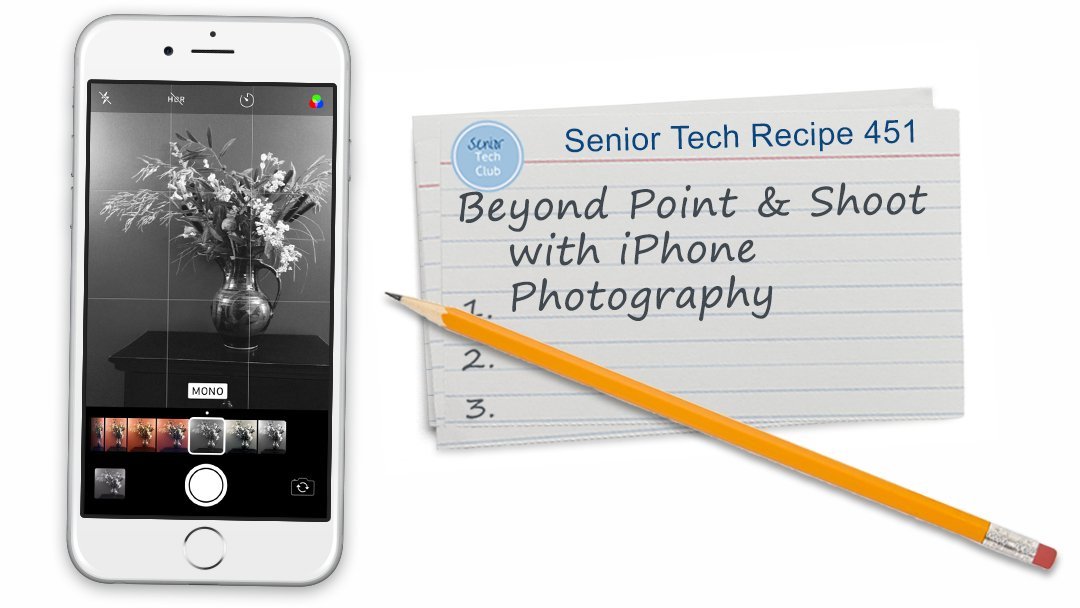
A great many iPhone users will use their iPhone cameras in a point and shoot fashion. They will pull out their camera, aim at their subject and press the shutter button to snap the photo.
With later iPhone models, the iPhone’s camera has included modes and features that take it into new territory. If you are only doing point and shoot, you may be missing some great photo opportunities.
The purpose of this recipe is to deliver quick tips for iPhone Photography. It includes:
- Flash
- Live Photo
- HDR
- Zoom
- Focus and Exposure
- Modes including photo, square, pano, video, time-lapse, and slo-mo.
Beyond Point and Shoot
The iPhone camera is a pretty good camera and it keeps getting better. Many of the improvements to the camera not well documented or actually visible. So the purpose of this recipe is to take you on a tour of the Camera app and identify its core capabilities to take you beyond point and shoot.
Launch the Camera App
See Recipe #430 The Basics of iPhone Photography – Let’s Point and Shoot on the basics of operating the Camera App including five ways to launch the camera app and four ways to release the shutter to take a picture.
A Tour of the Camera App
In order to take better pictures and take advantage of the primary capabilities of the iPhone came, let’s take a tour of the Camera app and it’s functions.
If you launch the iPhone, you will see the following elements on the screen in this step-by-step:
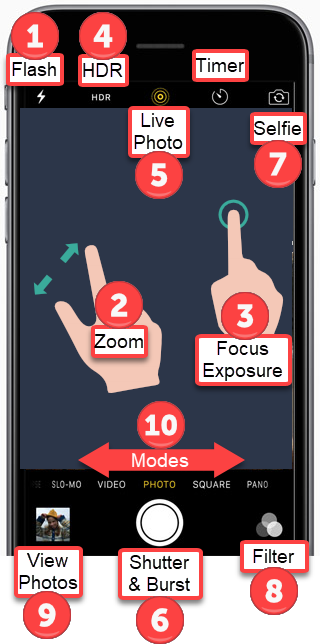
Step-by-Step description of the Camera App
1 Flash
If picture needs flash, the iPhone’s built in flash can add necessary light to a subject. Manage the Flash by pressing the Flash (lightning bolt) icon in the camera app.
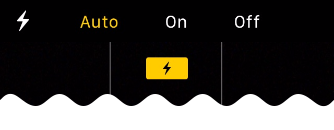
Control the Flash
The Flash function provides three settings:
- Auto – the Camera app will use the flash when warranted by light conditions. This is a reasonable setting to leave set.
- On – the Camera app will always use flash
- Off – the Camera app will not use flash.
 Senior Smart Tip: Flash not always needed
Senior Smart Tip: Flash not always needed
Those of us who learned about cameras in the Kodak era, recognize a rule that says that indoor pictures always required a flash. The iPhone camera is actually good in low light situations and the rule doesn’t always need to apply. In general, your photos are better without flash. Try the photo before you turn on the flash.
2 Zoom
The basic zoom function that is available in all iPhones is a digital zoom versus an optical zoom that comes with zoom lenses. Digital zoom is often disparaged because it lowers the image resolution of your picture and tends to expose flaws. Regardless, most people consider using the digital zoom because they want the image to appear closer. However, if given a choice you should move closer to your subject and take the picture without zoom.
The iPhone 7 Plus, 8 Plus and iPhone X, and iPhone 11,12 and 13 have a multiple lenses that provides a optical zoom or a wide angle view. If you iPhone has multiple lenses, this will apply an optical zoom to your photo.

The screenshot on the left (.5x) indicates a wide angle lens that will bring more subject into the photo. The middle is a 2x optical zoom. The 5x is a combination of 1x optical with 5x digital zoom.
3 Focus and Exposure

Use the slider to control the exposure (lighting)
The Focus and Exposure of your iPhone camera is usually managed by your iPhone. It generally does a good job. However you can manually set the focus and exposure by simply tapping on the spot on the screen that you wish to have the focus. For example, if you subject includes items in the foreground and background, tap the area of the screen that you consider to be your primary focus.
When you tap, you will get a slider on the screen (look for the sun) that allows you to change the exposure bias. You will see the image get lighter or darker.
AE/AF Lock – When you press and hold on the subject on the screen, you will lock the exposure and focus. This is particularly useful if you want to take multiple photos with the same exposure and focus. When locked, you will see an AE/AF (automatic exposure/automatic focus) Lock on the screen.
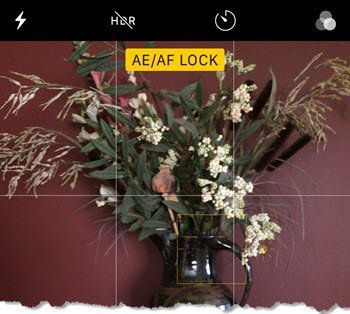
Press and Hold to get AE/AF Lock.
Tap another location on the screen to remove the lock.
4 HDR (High Dynamic Range)
In HDR mode, the Camera app takes multiple photos in rapid succession, at different exposure settings—and blends them together. The resulting photo has better detail in the bright and midtone areas. A good candidate for HDR is where the picture has both light and dark areas.
HDR is a good function and will improve the quality of your photos. Check out this Apple Support Doc for a specific photo example where the cloud patterns in a sky background appear on the photo using HDR.
iPhone 7 and Before
iPhone 7 and before have an HDR icon as shown in #4 in the tour graphic above. Using this icon you can control how HDR is used.
Tap the HDR button and you are presented with three HDR options, Auto, On and Off.
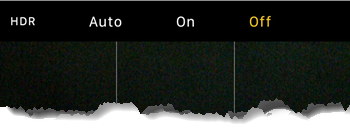
Control HDR
iPhone 8 and Later
With iPhone 8 and X versions, the HDR setting is removed from the screen. HDR Auto is on be default and the camera will simply sense when HDR is required and use it without any action by you. It’s a well-regarded function and unless you wanted fine control over your camera’s function we recommend you take advantage of the default setting. If you wish to restore the HDR on-screen control, you can turn off Auto HDR in Settings, Camera. Turning off Auto HDR will restore the HDR control to the Camera app screen.
5 Live Photo
The camera records with video what happens just before and after you take your photo, along with the audio. The result is a moving picture. Live Photos are available in iPhone 6s and later.

Live photos are either on (yellow) or off (white)
6 Burst shots
Burst shots can help you capture the action or look you seek by taking a rapid sequence of photo. Tap and hold the Shutter button to take rapid-fire photos in bursts. The shutter sound is different, and the counter shows how many shots you’ve taken. Lift your finger to stop.
To view burst photos, select the thumbnail in the Photos app and tap Select. Select the desired picture and tape Done. You are presented with an option to either copy the selected photo or deleted the other unselected photos. This process is covered in more detail in the recipe The Basics of iPhone Photography.
7 Selfie (Front or Rear-facing Camera)
Switch between front and back-facing cameras. Switch the camera to take a selfie with you or a group. Tip: Often it is easier to use the volume buttons to release the shutter when you are holding the phone like this.
8 Filters
Add a filter to add a special effect to a picture. A prime example is the mono filter which will take the picture as a black and white image. You can also add filters after the photo is taken in the Photos app.
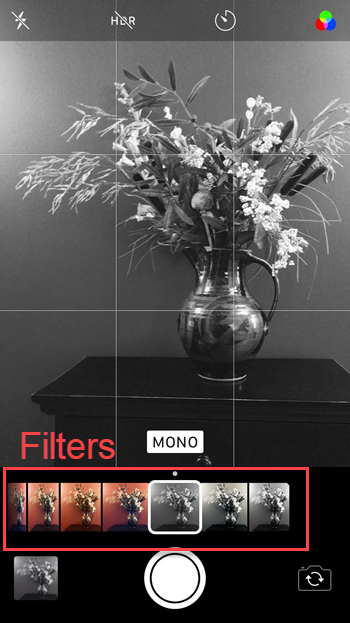
Select a Filter like MONO for black and white pictures
9 View Photos

Tap Camera to return to the Camera App after viewing photos
Tap to view your most recent photos and other in the Photos app. After viewing your photos, tap Camera to return to the Camera app.
10 Modes
Your iPhone Camera has several photo modes, allowing you to shoot still, video, panoramic or more. Here are definitions and essential tips for each mode:
- Photo – Use to take traditional still photos.
- Portrait – Available on iPhone 7 & 8 Plus models to achieve a depth of field effect for portraits, e.g. clear face, blurry background.
- Square – Provides the framing and image preferred for social media platforms like Instagram.
- Pano(ramic) – Use Pano to capture a wide angle photo that won’t fit on a single camera screen.
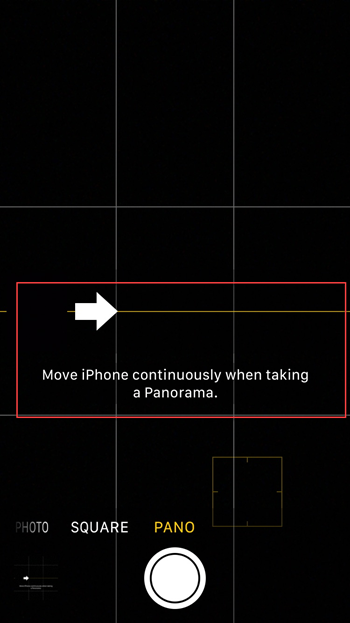
On screen instruction to Pano Mode
Pano Instruction: Tap shutter, Move camera in the direction of the arrow. Tap shutter to end.

Pano Sample – Boston Harbor taken by Don
- Video – Shoot high quality movies with your iPhone.
Video Instruction: Tap the shutter to start recording. Tap again to end the video. Note how the shutter button is red for video.
- Time-lapse – Create time lapse video of activities or events where you want to record progress.
Time-lapse Instruction: Tap the shutter to start and end. Prop your phone in stationary position or use a tripod.
- Slo-mo Take video that you play back in slow motion. Great for special effects or capturing a fast activity.
 Smart Tip: Preserve your Settings
Smart Tip: Preserve your Settings
I have had students come to me and express their dislike of Live photos. Is there a way to turn off Live photos by default. There isn’t a Live photos setting but it is possible to have the camera remember or preserve your previous settings. So if you had manually turned Live Photos ‘Off” your Camera app would remember the change.
Make this change with the following actions:
Tap Settings, Camera, Preserve Settings, Life Photo or Camera Mode

Tap to set the green.
Check for Understanding
Use the following questions to determine if you need to read or study this recipe. You might already have an understanding of this topic. Following your study, answer the same questions to help you check your understanding of the skills taught in this lesson.
- Do you know how to manage the Flash on your iPhone/iPad camera?
- What is HDR?
- What is Live Photo?
- Give two examples of Modes and how they are used.
Additional Information
The Senior Tech Club recommends the following additional resources for members that wish to pursue additional and/or advanced information on this recipe:
Apple Support – Take and edit photos with your iPhone, iPad, and iPod touch
